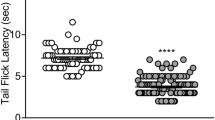Abstract.
Rationale: Repeated treatment experiments with high and low efficacy agonists provide critical insight into possible mechanisms underlying development of opioid tolerance. Objective: Experiments in a tail-withdrawal assay tested the hypothesis that magnitude of tolerance to antinociceptive effects is inversely related to agonist relative efficacy in rats intermittently treated with etonitazene, morphine, or buprenorphine. Methods: The antinociceptive effects of five µ opioid agonists were tested in male, Sprague-Dawley rats in a warm-water tail-withdrawal assay. To induce tolerance, escalating doses of the higher efficacy agonist etonitazene, the high efficacy agonist morphine, or the lower efficacy agonist buprenorphine were administered twice daily for 2–8 weeks. Results: Etonitazene, etorphine, morphine, buprenorphine, and GPA 1657 [(1)-β-2′-hydroxy-2,9-dimethyl-5-phenyl-6,7-benzomorphan] produced dose-dependent increases in tail-withdrawal latency until 100% maximum possible effect (%MPE) was obtained. Treatment with escalating doses of etonitazene, morphine, or buprenorphine produced greater tolerance to the lower efficacy agonists buprenorphine and GPA 1657 than to the higher efficacy agonists etonitazene, etorphine, and morphine. Treatment with buprenorphine, a lower efficacy agonist, produced greater tolerance than did treatment with equivalent doses of the higher efficacy agonists morphine or etonitazene. Conclusions: Taken together, these data suggest that magnitude of antinociceptive tolerance is inversely related to relative efficacy of µ agonists, with lower efficacy agonists being more susceptible to tolerance than are higher efficacy agonists under these intermittent dosing conditions.
Similar content being viewed by others
Author information
Authors and Affiliations
Additional information
Electronic Publication
Rights and permissions
About this article
Cite this article
Walker, E., Young, A. Differential tolerance to antinociceptive effects of µ opioids during repeated treatment with etonitazene, morphine, or buprenorphine in rats. Psychopharmacology 154, 131–142 (2001). https://doi.org/10.1007/s002130000620
Received:
Accepted:
Issue Date:
DOI: https://doi.org/10.1007/s002130000620




